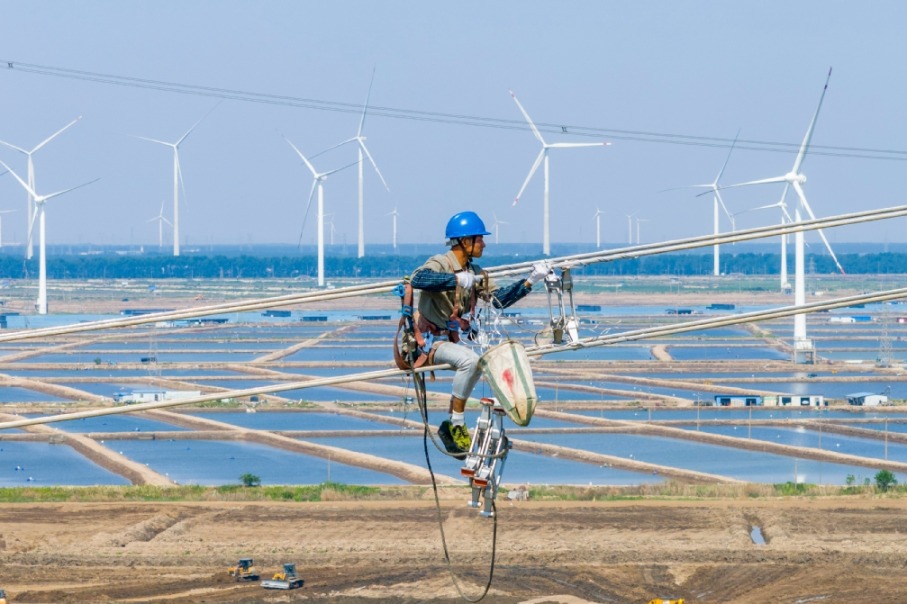Ready for the big move

|
Yishion, a clothes brand which targets the youth market, plans to set up more research and design centers in the US and Europe to expand its presence in developed markets. [Nan Shan / For China Daily] |
Dongguan garment maker to strengthen overseas presence
When Guo Donglin, a former fruit peddler, decided to start a garment factory in Dongguan, Guangdong province in 1997, little did he realize it would become a multi-billion yuan enterprise producing trendy affordable fashion for a predominantly young clientele.
Over the years, the company has grown beyond the small unit in Dongguan to become a big enterprise with more than 30 factories that employ some 30,000 workers and more than 1,400 local and foreign designers. Production has grown considerably and by the end of last year the company had an annual production capacity of 40 million pieces of garments.
Having clocked impressive sales numbers of more than 5.8 billion yuan ($920 million, 700 million euros) and creating a network of over 4,500 sales outlets across China, one would have expected the company to be content with its achievements. But that has not been so.
Yishion is now looking to make a mark in the more developed global markets even as it continues to make strides in other developing countries and boost its domestic market share.
Tao Defu, assistant to the board chairman and company spokesman, says the company is looking to establish a strong presence in the United States and the European Union over the next five years. Along with it are also the plans to grow the number of stores in places such as Russia, Cambodia, Vietnam, Malaysia, Indonesia and the United Arab Emirates.
Making the overseas move is a logical step for Yishion, says Tao. "Most of the European and US garment brands are in a spot of bother as many domestic expansion plans have been grounded due to the financial crisis. There is an opportunity for companies like ours to test the developed markets with our trendy and affordable products."
Tao, however, admits it will be a tough challenge considering that several European and US brands are trying to make inroads into the huge Chinese market. "It is a tough market situation as the foreign players are not only aggressive with marketing campaigns like 'buy one get one free', but also setting up more and more stores in second- and even third-tier cities of China."
Yishion's strategy, till date, has been to target the youth market in China, a strategy that has paid off. This year, the company anticipates a 30 percent growth in sales to 8 billion yuan.
The company's next plan is to set up more research and development centers in the US and Italy along with fashion design centers in Paris and Tokyo. It has already set up a design center in London and currently employs 24 local designers.
"There are several garment makers from Dongguan who can compete with the international brands in the domestic market. But the real challenge will be competing with leading international brands in the developed markets," says Chen Guanghan, professor of economics and director of the center for studies of Hong Kong, Macao and the Pearl River Delta at Sun Yat-sen University in Guangzhou.
Chen says big players such as Yishion have the requisite financial and production strengths to compete with foreign rivals.
"We believe that foreign styles, ideas and the huge Chinese market will be the catalysts for growth and profits. It is also an opportunity to bring the latest fashion trends of the West to China," says Wei Wen, assistant to Yishion's general manager.
To that extent, the investment in the fashion design centers will pay off in the long run, Wei says.
"We have no plans to send Chinese designers to join the team in London, as we want them to independently carry out fashion trend analysis and come up with designs for Chinese customers," Wei says.
The company initially focused on making leisure dresses, but has since moved on to a wide range of affordable garments like children's wear, sportswear and business-casual dresses.
Pricing has been the prime mover for the brand's success and the company hopes it will also be able to retain the advantage in overseas markets. A Spring jacket from Yishion costs about 300 yuan, which is nearly half the price for products from foreign brands like Gap or Levi's.
But what really sets Yishion apart from its peers in Dongguan is that it does not undertake OEM (original equipment manufacture) for foreign companies. Rather, the company believes that growing its core market is the key to future profits.
"Demand for leisure wear may be growing rapidly in the West, but in China it has always been affordable trendy wear that has seen maximum growth," Tao says. "For improving sales, it is important for companies to be keenly aware of trends like the income level of young people, monthly living expenses of university students, the consumption habits of teenagers' parents, and also to come up with garments that are durable and environmentally-friendly."
Foreign companies are more adept in determining fashion trends, consumer preferences and mature sales practices, Tao says. Local garment companies have often not paid enough attention to investment, brand promotion and effective sales strategies.
But Tao says this does not mean that Chinese brands are incapable of competing with foreign rivals. "We are living in an era of borderless economic integration and we must use the chance to build our brand and market reputation," he says.
Unlike others, Yishion has been spending considerably on brand promotion and marketing strategies. It has also roped in Han Geng, a well-known Chinese male singer and dancer, to endorse its products. The company spent nearly 100 million yuan on marketing campaigns in China last year.
In contrast to the dresses or trousers with European or US price tags, Chinese consumers such as college students and the young working class are keen on buying locally-made European or Japanese styles or patterns. While this gives companies like Yishion or Jeanswest more opportunities to grow their domestic market share, they are also determined to make a journey to the West.
You may contact the writers at zhongnan@chinadaily.com.cn and liwenfang@chinadaily.com.cn.
Today's Top News
- China opposes any tariff deal made at its expense: commerce ministry
- Nepal's hydropower a climate change solution
- UN Charter still guiding compass of humankind
- Leaders pledge to strengthen Sino-Senegalese relations
- China, Ecuador to support each other's core interests
- Details on trade talks confirmed































